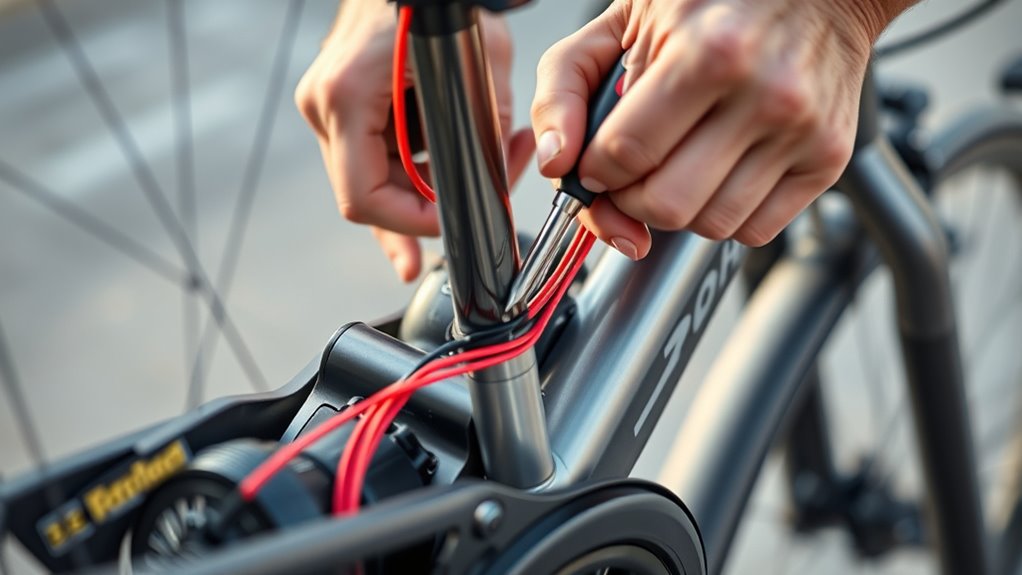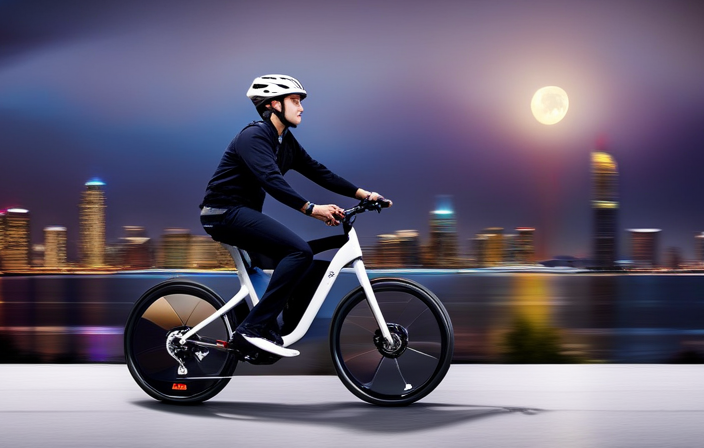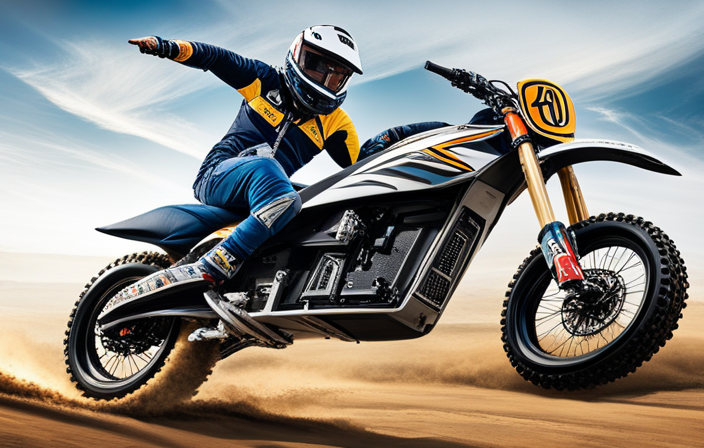To keep your e-bike in ship-shape, perform daily checks like inspecting tires, brakes, and the battery for any damage or wear. Regularly clean and lubricate the chain, and verify your tire pressure and brake pads are within recommended levels. Schedule professional tune-ups every few months, especially before and after seasonal rides, to catch hidden issues early. Staying on top of maintenance helps your e‑bike deliver safe, reliable performance—learn more about keeping it pristine by continuing your efforts.
Key Takeaways
- Perform daily visual checks, including tire pressure, brake function, and battery condition, to ensure safety and reliability.
- Regularly clean, lubricate, and inspect the chain, drivetrain, and gears for optimal performance.
- Maintain proper tire pressure and inspect rims for damage after rough terrain rides.
- Check and adjust brakes and hydraulic calipers for responsiveness and even wear.
- Schedule professional inspections every 3-6 months to address hidden issues and ensure system longevity.
Regular Checks and Daily Upkeep
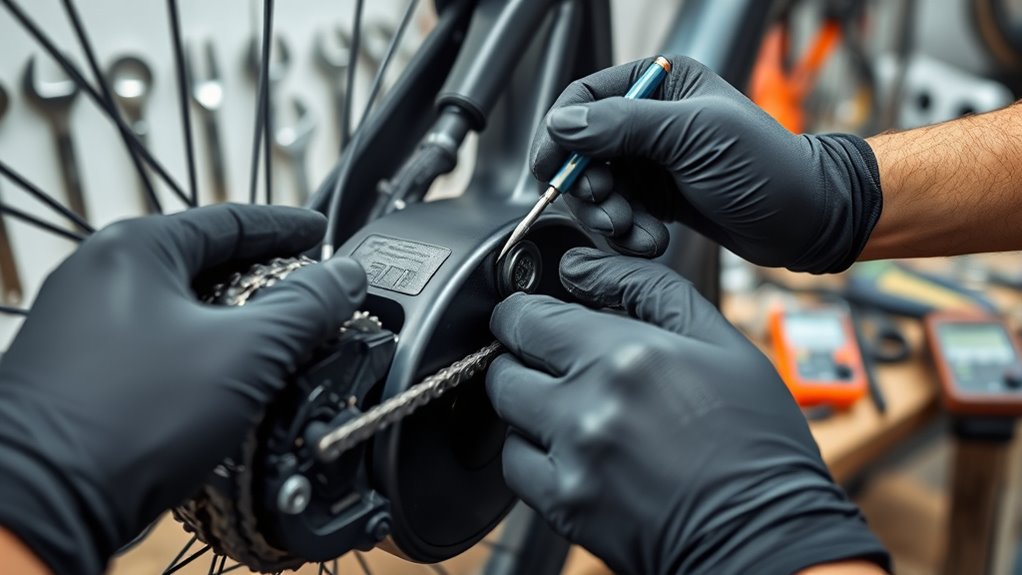
To keep your e-bike running smoothly and safely, it’s essential to perform regular checks and daily upkeep before each ride. Start with a visual inspection to spot loose screws, damage, or unusual noises. Check your tire pressure, ensuring it matches the recommended PSI to prevent flats and optimize ride quality. Inspect the brakes for responsiveness and examine brake pads for wear, replacing them if necessary. Conduct a battery check for any signs of corrosion or damage, making sure it’s properly seated. Wipe down the frame and accessible components with a dry microfiber cloth to remove dirt and grime. Regularly inspect the chain for lubrication needs to prevent rust and ensure smooth operation. These daily upkeep routines help minimize wear and tear, keeping your e-bike in top condition. Additionally, verifying the air quality within your storage area can help prevent corrosion and prolong the life of electronic components. Incorporating preventative maintenance routines, such as checking electrical connections, can further safeguard your system against unexpected issues. Ensuring proper air filtration in your storage environment can also contribute to the longevity of sensitive parts. Moreover, inspecting the battery connection periodically can help maintain optimal power transfer and overall performance.
Tire and Brake Maintenance

Maintaining your e-bike’s tires and brakes is crucial for safe and efficient riding. Regularly check tire pressure and keep it within the recommended PSI, usually 40-60 PSI, for peak performance and safety. During tire inspection, look for rim damage or cracks, especially after riding over rough terrain. Inspect brake pads every 500-1000 miles; replace them if the friction material is less than 1.5mm thick. Clean brake rims and pads regularly to prevent dirt buildup, which reduces brake responsiveness and causes uneven brake wear. For hydraulic brakes, ensure brake calipers are properly aligned and perform brake adjustment as needed. Keep an eye on rim integrity and replace damaged rims promptly to avoid further issues. Proper maintenance ensures reliable braking and a smooth ride.
Chain, Drivetrain, and Lubrication
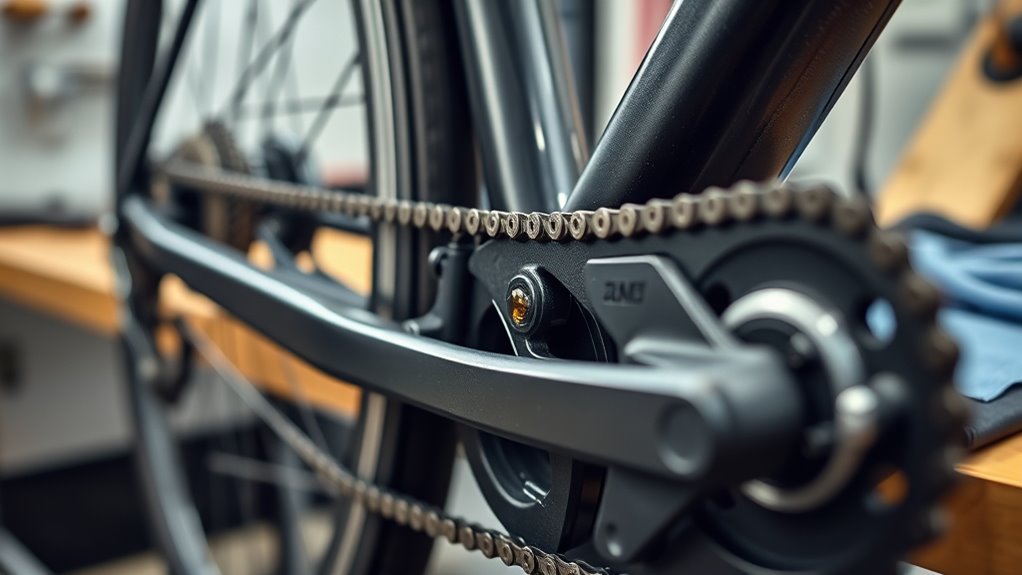
Keeping your e-bike’s chain and drivetrain in top shape is essential for smooth, efficient riding. Regularly clean and degrease the chain weekly with a bike-specific chain cleaner to prevent dirt buildup that hampers gear shifting. Lubricate the chain every 2-3 rides with dry or wet lube, depending on conditions, to reduce friction and wear. Use a chain wear tool to monitor chain elongation; replace the chain promptly if it exceeds 0.5% wear to protect your cassette and chainrings. Keep gear components, including cogs and the derailleur, free of dirt and debris for ideal power transfer. Periodically adjust derailleur tension and indexing to maintain precise gear shifting. Proper maintenance of the chain and drivetrain ensures smoother rides and prolongs the life of your gear components. Regular inspection and care can also help identify excessive chain wear early, preventing costly replacements. Additionally, understanding the role of gear ratios can optimize your riding efficiency and performance. Staying informed about advances in drivetrain technology can help you choose the best upgrades and maintenance practices. Utilizing predictive maintenance tools can further enhance your ability to keep your system in optimal condition.
Battery and Electrical System Care
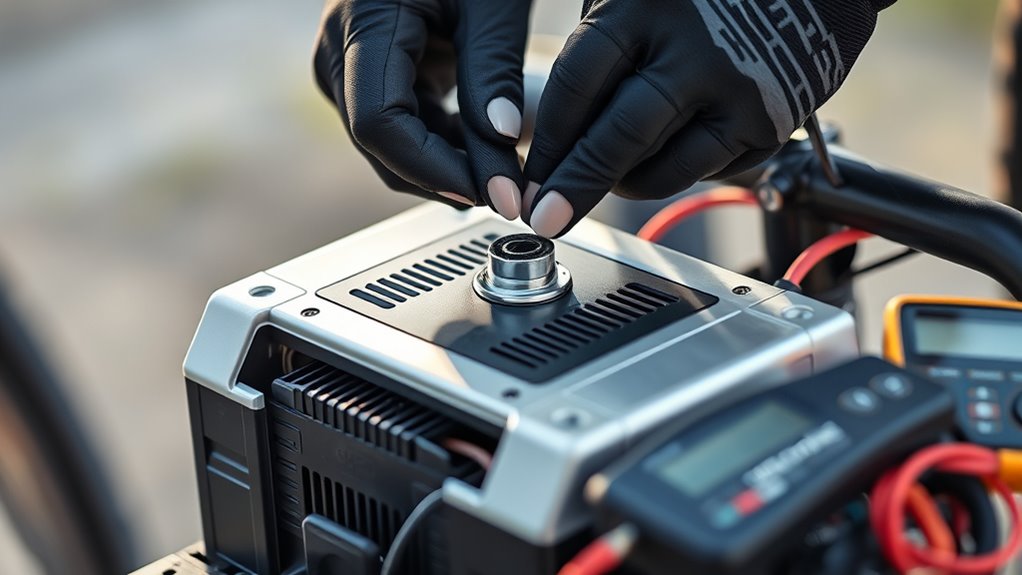
A well-maintained battery and electrical system are essential for reliable e-bike performance. To keep your system in top shape, follow these steps:
- Regularly inspect the battery for cracks, damage, and corrosion, and keep it clean and dry. Visual inspection helps identify potential issues early before they affect performance.
- Use the manufacturer-recommended charger and avoid charging outside the 20-80% range to prolong lifespan.
- Store the battery in a cool, dry place at about 50% charge during long periods of inactivity.
- Check wiring and connections for wear, corrosion, or loose contacts, ensuring the electrical system stays reliable.
- Regular maintenance helps prevent damage and ensures that your wiring and connections stay safe and functional. Additionally, battery care involves monitoring voltage levels to prevent over-discharge, which can significantly extend the lifespan of your e-bike’s electrical system. Proper charging practices can also help reduce the risk of thermal runaway and other battery-related issues. Keeping connections clean and tight is crucial for optimal electrical flow and overall system safety. Incorporating Mazda Tuning principles such as checking for loose connections and upgrading wiring can further enhance system reliability.
Proper maintenance prevents damage, preserves performance, and guarantees your wiring and connections stay safe and functional. Consistent inspection and care keep your e-bike running smoothly.
Seasonal and Professional Servicing
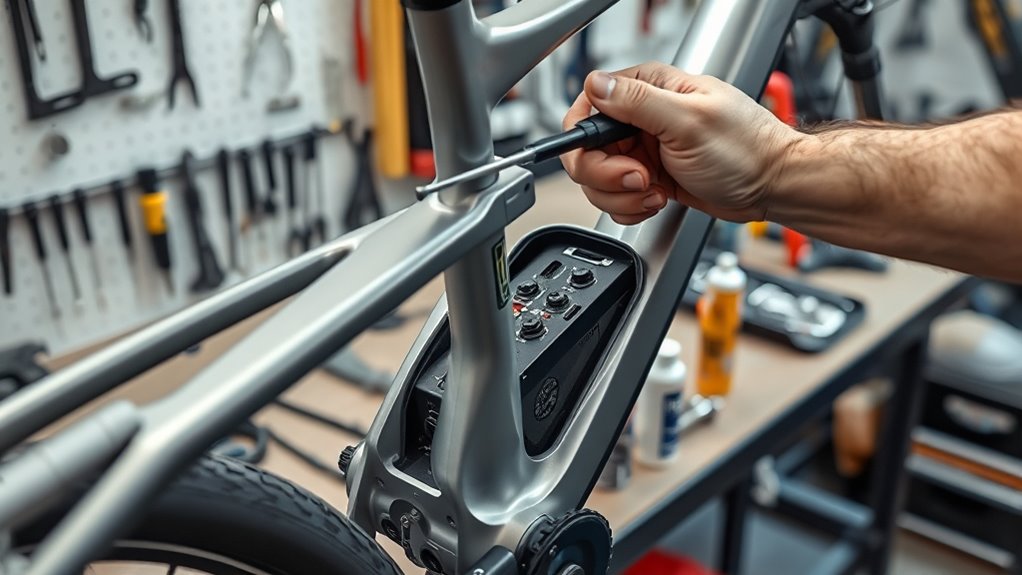
To guarantee your e-bike performs reliably across different seasons, scheduling regular seasonal servicing is essential. Every 3 to 6 months, you should have a professional inspection of the battery, drivetrain, brakes, and suspension to ensure maximum performance in changing weather. Seasonal servicing includes checking the electrical system, brake adjustments, and a full system diagnostics to catch potential issues early. In colder months, store your e-bike indoors and fully charge the battery to prevent capacity loss. An annual professional maintenance visit, or every 1,000 miles, helps identify hidden problems like motor wear or electrical faults that DIY inspections might miss. Proper seasonal and professional servicing not only extend your bike’s lifespan but also maintain safety and reliability year-round. Regular inspection metrics can help monitor your e-bike’s condition between professional checkups. Incorporating AI-powered diagnostics into maintenance routines can further optimize performance and preemptively address issues. Additionally, understanding the importance of environmental impacts can encourage more sustainable maintenance practices and reduce unnecessary repairs. Staying informed about local business hours can also ensure you find the right service providers at convenient times. Virtual hackathons can also provide innovative solutions for e-bike technology and maintenance.
Frequently Asked Questions
What Maintenance Do E-Bikes Need?
You need to regularly clean your e-bike’s frame, components, and electrical parts to prevent dirt buildup and catch issues early. Lubricate the chain every 2-3 rides and check it weekly for wear. Keep the battery clean, dry, and follow proper charging routines. Inspect brakes, suspension, and bolts periodically, and seek professional help for complex repairs or diagnostics to keep your e-bike running smoothly and safely.
What Is the Average Lifespan of an Ebike?
You’re probably wondering about the lifespan of your e-bike. With proper care, it typically lasts between 5 and 10 years. Batteries usually need replacing after 3 to 5 years, while drivetrain parts like chains and sprockets may last 1,000 to 3,000 miles. Regular maintenance, professional servicing, and good storage habits can help your e-bike go beyond 10,000 miles and extend its overall lifespan.
Is It Bad to Leave an Ebike Plugged in All the Time?
Leaving your e-bike plugged in all the time isn’t ideal. Even though modern batteries have management systems, continuous charging can cause unnecessary wear and degrade capacity over time. You should unplug your bike once it reaches full charge, usually indicated by a light or display. For long-term storage, keep the battery charged around 50-80%. Regularly unplugging it helps maintain battery health and prevents electrical issues.
What Is the Maintenance Required for an Electric Bike?
Imagine you’re riding your e-bike daily; to keep it running smoothly, you need regular maintenance. You should inspect and clean the battery, connectors, and wiring to prevent corrosion. Lubricate the chain weekly, tighten bolts, and monitor battery charge levels to extend lifespan. For complex parts like the motor and display, schedule professional diagnostics. Consistent care guarantees your e-bike remains reliable and performs at its best.
Conclusion
By staying on top of regular maintenance, you’ll keep your e-bike running smoothly and extend its lifespan. Did you know that proper tire inflation alone can improve your bike’s efficiency by up to 3%? Simple daily checks and seasonal servicing can save you money and prevent costly repairs down the line. So, take a little time to care for your e-bike—your rides will be safer, smoother, and more enjoyable every time you hit the road.
